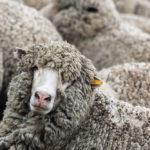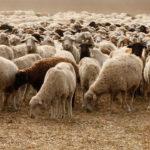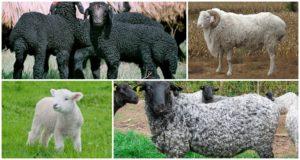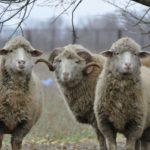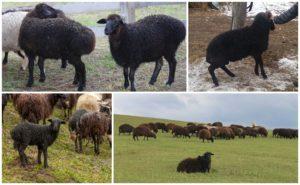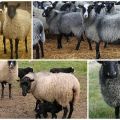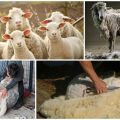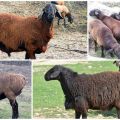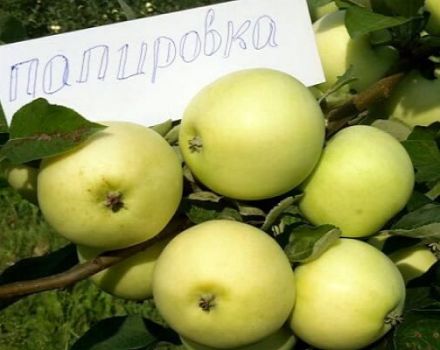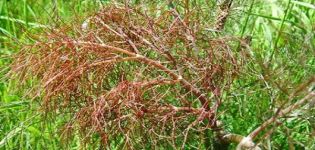Description and characteristics of Dagestan sheep breed, diet and breeding
Each region of Russia has its own sheep breeds. In Dagestan, local fine-wool sheep of the meat-and-wool direction are widespread. Consider the description and characteristics of the Dagestan ram, its purpose and productivity, advantages and disadvantages. As well as the rules of maintenance, care, nutrition, breeding. What diseases can Dagestan sheep get sick and how to prevent them in the household.
History of the breed
The breed was bred in Dagestan, selection work was carried out from 1934 to 1950. Coarse-wooled local sheep and Württemberg rams were used. Their offspring began to breed "in themselves", kept on free grazing in the mountainous regions of Dagestan. The goal was set by the breeders to obtain fine-fleece animals adapted to the mountain climate.
Description and productivity
Dagestan breed of meat and wool direction, fat tail. The constitution of animals is strong, the body is large, proportional, the peculiarity is the low sacrum. Sheep weight - 45-50 kg, rams - 75-80 kg. Wool is white in color, homogeneous structure. Its length in males is 8-10 cm, in females - 7-8 cm. Wool yield - 50-58%, volume in rams - 2.8-5 kg, in sheep - 1.5-2 kg.
Pros and cons
Despite the shortcomings, the breed is widespread in its homeland. Because the Dagestan rams and sheep with a thin fleece are adapted to grazing, effortlessly overcome long distances along the slopes and stones.
Maintenance and care
Dagestan sheep and rams do not need special maintenance. In the summer they are kept in grazing, where they are constantly. They have a thick coat, so the animals do not suffer from temperature extremes, cold or heat. In winter, animals should live in a room - warm, bright, spacious. It must maintain a relatively constant temperature and humidity.
In addition to an enclosed space, it is necessary to equip a walking area for Dagestan sheep.They are not afraid of the cold, so you can walk them in cold weather.

Feeding the sheep
The lamb feeds on milk until 2 weeks of age. Then it needs to be fed with bran and oats. By the age of one month, you can add grated vegetables, root vegetables, soft thin-leaved hay. At 3 months, the lambs are weaned from their mother.
Adult animals are grazed on the grass, hay and silage are provided in winter. They are fed with vegetables, melons, root crops. Of roughage, in addition to hay, they provide straw and haylage. They feed concentrates, various types of grain, bran, legumes, soybean and sunflower cake. You can raise Dagestan sheep on a complete feed.
For fattening animals for meat, it is recommended to feed concentrates with a high protein content: peas, corn, barley. This promotes the fastest building of muscle mass.
In caring for the Dagestan breed, not only the diet is important, but also the frequency of feeding. During the stall period, feed 3 times a day, give nutritious food in the morning and in the afternoon. Water the animals after each feeding. Give grain after drinking, before it - juicy food. In summer, if the flock is grazed on grass-rich pastures, no additional feeding is needed for the sheep. The health and growth of young animals, the productivity of adult animals depend on how the nutrition is organized. If the females are well fed, the number of pups in the litter increases.
How is it bred?
The mating of Dagestan sheep and rams is timed to August-September. Females can occur at 1.5 years of age, although puberty occurs by 6-8 months. At the time of mating, they should weigh the same as adult animals. There can be 3-4 dozen females for 1 ram.
Pregnancy lasts 5 months, during gestation, the female needs to be fed hearty and often. With a lack of nutrients, lambs are born weak, the mother can refuse them. There are 1-2 lambs in the litter, rarely more, maximum 5 cubs. To obtain pedigree offspring of Dagestan sheep, they happen to Dagestan rams. Males are used for crossing with sheep of other breeds, as improvers. Hybrids inherit the best qualities of both parents.
Diseases
Suffer from infectious diseases of small ruminants. They are able to quickly spread from one animal to another, especially when kept together. Infections lead to a sharp decrease in flock performance and an increase in deaths. Treatment after diagnosis should be prompt. Antibiotics are used to fight infections. In addition to infections, helminths and external parasites harm sheep. Lice and fleas not only bother animals, but also spoil the quality of the wool and skins.
Prevention - keeping sheep and rams in a clean room, changing bedding, cleaning and disinfecting feeders, drinkers and equipment. Keeping new animals in quarantine. Separate from the rest of the flock, keeping females with lambs up to 3 months of age.
The Dagestan breed gives meat and wool. It is adapted to be kept in mountainous areas, but it will feel comfortable in regions with a similar climate. The breed can be kept in the household to obtain meat, milk, shear soft, warm wool from sheep.
